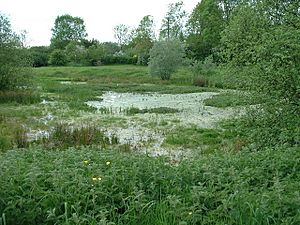East Walton and Adcock's Common facts for kids
| Site of Special Scientific Interest | |
 |
|
| Area of Search | Norfolk |
|---|---|
| Interest | Biological Geological |
| Area | 62.4 hectares (154 acres) |
| Notification | 1995 |
| Location map | Magic Map |
East Walton and Adcock's Common is a special natural area in Norfolk, England. It's located south-east of King's Lynn. This place is important for both its amazing plants and animals (biological) and its unique land features (geological).
It covers about 62.4 hectares, which is like 154 football fields! Because it's so special, it's called a Site of Special Scientific Interest (SSSI). This means it's protected by law to keep its nature safe. It's also part of a bigger protected area called the Norfolk Valley Fens Special Area of Conservation.
Why is This Place Special?
East Walton and Adcock's Common is a very important spot for nature. It's protected because of its unique landscape and the rare plants and animals that live there.
Land Shaped by Ice
The land here has special dips and ridges. These were formed a long time ago during the Ice Age. Scientists call these dips "periglacial depressions." They were created by freezing and thawing cycles near glaciers. This makes the common a great place to study how ice ages changed the Earth.
Amazing Plants and Animals
This common has many different types of natural areas, called habitats. You can find chalk grassland, natural springs, open water, and areas with bushes and small trees (scrub).
The plant life is incredibly rich. In just one square metre, you might find up to 32 different kinds of grasses and other small plants! This variety is very important for many creatures.
The common is also home to a huge number of invertebrates. These are animals without backbones, like insects, spiders, and worms. Many of them are very rare. In fact, seven species found here are on the IUCN Red List, which means they are endangered or at risk. There are also 79 other species that are considered rare in the whole country! This makes East Walton and Adcock's Common a vital place for protecting biodiversity.

